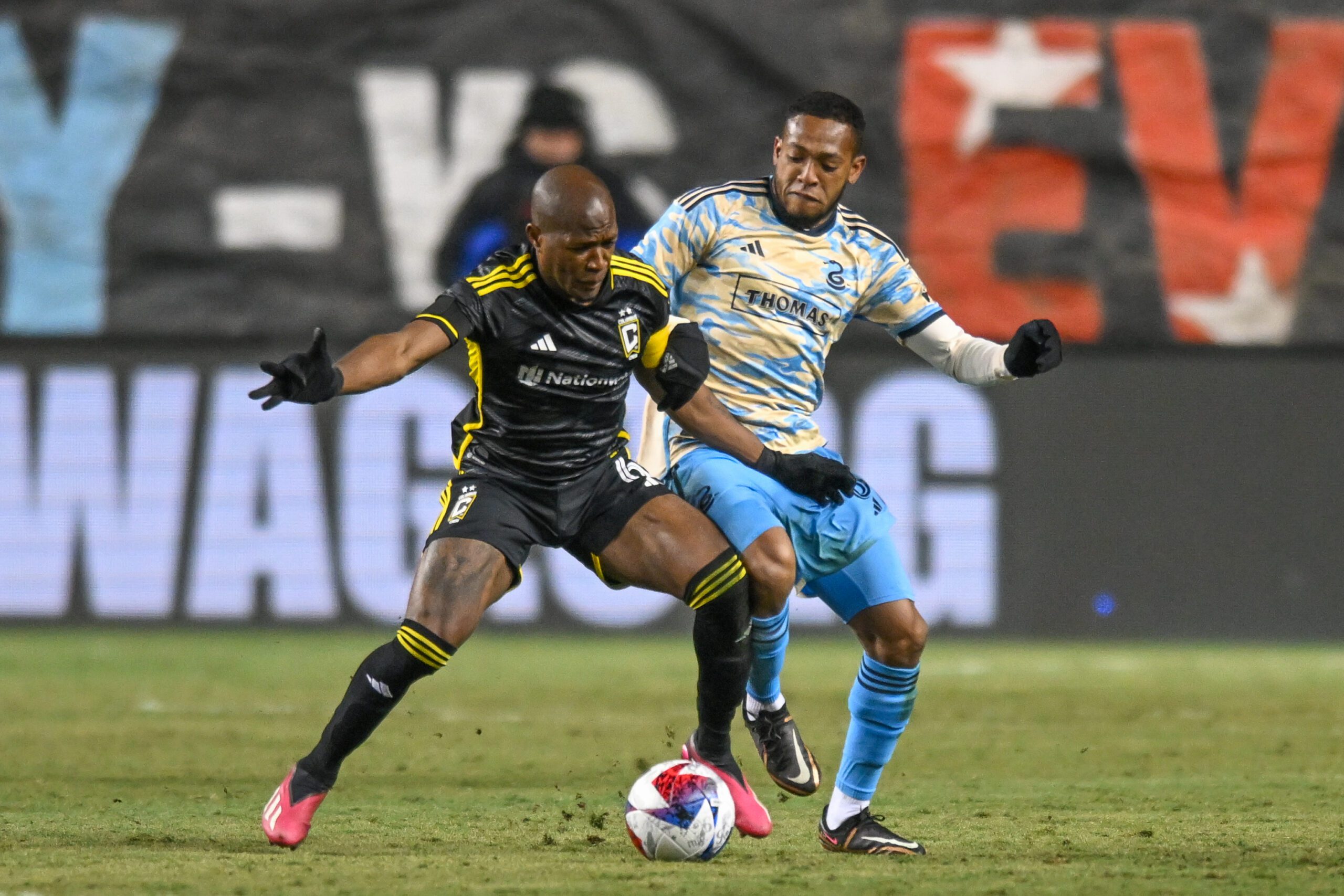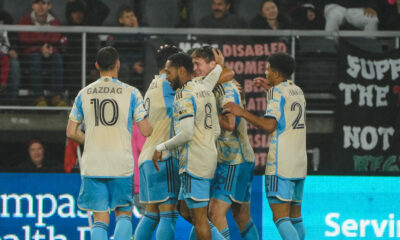Brotherly Game
Union’s intensity makes the difference to start the second half

The Philadelphia Union came back from a 1-0 deficit to record an impressive 4-1 win against Columbus on Saturday night at home.
The Crew, in Wilfred Nancy’s first game in charge, troubled the Union in the opening stages of the game with lots of possession. The Union scored two penalty kicks on the night from handballs, and the first came late in the first half to tie the game after the Union had been frustrated.
When the second half started, the Union came out with a renewed intensity and a higher press, and after taking the lead in the 50th minute, they never looked back.
Let’s start with the big picture. The final xG was 3.4-0.5 for the Union, and the halftime xG was 1.4-0.1. Removing penalty kicks, the final xG was 1.8 for the Union and 0.7 at halftime.
I think both penalties were harsh to the Crew as unfortunate handballs, but a non-penalty xG of 1.8 to 0.5 reflects the Union’s overally dominance of the game. I can also understand that had Columbus gotten to halftime with a 1-0 lead without a handball, this game could have been different, but the Union’s halftime adjustments would have been similar.
To dive in further, I want to bring back my top-line keys to the game from the preview: the strikers’ workrate against an inexperienced back three, the ability to disrupt Darlington Nagbe’s buildup, and the ability to track Lucas Zelarayan and Cucho Hernandez. I also mentioned that it would be a good game to see what Joaquin Torres would do.
Not to pat myself on the back too much, but those were good keys. When the Union pressed higher and put the Columbus backline under pressure, they were able to gain control in the game. Hernandez’ movement in the first half was superb and led to the goal, but the Union overall contained both dynamic talents well.
And yeah, Joaquin Torres’ dribbling ability was as advertised, undressing MLS rookie Philip Quinton just 20 seconds into his appearance off the bench before playing in Carranza for an easy finish on the fourth goal.
Carranza with a brace thanks to Torres' stunning assist.
Can we all please just admire Joaquin in this exact moment. Oh my goodness. #PHIvCLB 4-1 | #DOOP pic.twitter.com/yLe9eeKeYm
— PhilaUnion (@PhilaUnion) February 26, 2023
Before going deeper, it’s worth mentioning that the preseason hype for the Union is completely justified. They have the best starting XI in the league, and the best depth in the league. The pressure is on this team, but it’s one of the best rosters ever assembled.
To run through the game, I’ll start with Nancy’s lineup. He included Quinton at center back and Patrick Schulte at goalkeeper. Both made their first ever MLS start. Nancy left out Josh Williams, and so Steven Moreira played right center back, and relatively untested wingbacks Mohamed Farsi and Will Sands got the nod.
It was an inexperienced lineup, but the Crew managed to take it to the Union early by moving the ball around the field with lots of quick passing.
“First 15 minutes, we didn’t touch the ball,” said Jim Curtin. “You can see the ideas Wilfred is going to have with them… It’s a unique formation, a unique way of playing … When we gave them time and space, we were chasing.”
The Union forwards couldn’t get enough pressure on the ball early, and Nagbe was dictating the flow of the game. When the Union did have the ball, the Crew were packed in the middle of the field and there was almost no room to build up.
Moreira was pressed very high on the right, and so was Farsi. This gave Kai Wagner no room to breathe, and centrally, Zelarayan, Alex Matan, Aidan Morris and Nagbe were enjoying a numbers advantage over the players in the diamond.
This was the Crew’s first half passing network, and Moreira’s advanced positioning helped the Crew effectively have seven-ish players on the middle line.

The Union countered by playing balls over the top and at the Crew backline, and they forced numerous mistakes, including a few from Quinton. José Martínez nearly found Bedoya over the top but the captain was just offside.
When the Crew did make those mistakes, the Union either didn’t have sharp touches or were whistled for borderline fouls.
“Every 50-50 didn’t go our way, and we seemed surprised when we did get mistakes,” said Curtin, specifically on the referee’s whistle.
The Union were still dangerous on set pieces, and on at least three occasions put together goalmouth scrambles that contributed to a 0.7 first half non-pen xG. They couldn’t score or find a stable foothold in what was, quite frankly, a frustrating outing.
That was compounded with the Crew goal, which came from a miscommunication in building out between Glesnes and Blake. Glesnes was forced to hoof it long, and the Crew immediately sprung Nagbe in transition. He found Cucho, who kept drifting off the backline on the right, and he was able to find a deflection off Matan for the lead.
It’s worth mentioning that while the handball minutes later to tie the game was lucky, the set piece that the handball happened on was won by Martínez, who was excellent all game.
The Union came out of halftime with a much higher work rate, starting with the strikers, and Bedoya and Flach both shifted inside to firm up the midfield numbers. Mbaizo pushed higher on the right to compensate for Bedoya’s narrowness, and the Union were able to effectively deny space to Columbus in the same way Columbus did to Philly early in the game.
The second goal came from Martínez at his best again.
“It came from a ball won in midfield, José being aggressive and a forward pass,” said Curtin.
CAPPY ➡️ KING JULIAN
UNION TAKE THE LEAD IN THE 52ND MINUTE!#PHIvCLB 2-1 | #DOOP pic.twitter.com/weaeb0MfNc
— PhilaUnion (@PhilaUnion) February 26, 2023
The two plays from the sequence are circles in the maps of Jose’s defensive actions and passes.

When Martínez is winning the ball that high up the field and playing progressive passes, he is the best defensive midfielder in the league.
From that play, Bedoya and Carranza ran riot to take a 2-1 lead, and the Union didn’t look back. The third goal might have been a fortunate penalty, but the Crew were unable to string together the same metronomic passing sequences they enjoyed early in the game.
Here are a few more illustrative maps that demonstrated the Union’s control of the game.
First the difference in key passes between the two teams.
The Union’s key passes:

And the Crew’s:

Despite an overall 59-41 percent edge in possession for the Crew, they only managed five key passes. And due to the work of Glesnes, who chased Zelarayan no matter how deep he dropped, he was unable to turn into space.
“Jakob looked like a midfielder tonight, to chase Zelarayan,” added Curtin. “If you let him receive the ball with nobody on him he can hurt you.”
Here’s Zelarayan’s pass and shot map:

There just are not a lot of forward passes (squares), and none centrally.
Ultimately, the Union were both good and fortunate in this game, and their adjustments to further tilt the game towards their style in the second game proved decisive. Once denied space in the middle, the Crew did not have enough playmaking on either wing (Farsi, Sands, and Luis Diaz, who was subbed on for Sands at halftime), or the desire to launch balls into the Union’s backline, to get the ball to their best players in the right areas.
Curtin started his press conference by praising the Crew, and I suspect most teams will not be able to keep this attack in check the way the Union did tonight. Wilfred Nancy didn’t finish second last season in the East by not knowing how to play against pressing teams. The Union were dominant, without getting into full gear, and that should be enough to scare the rest of the league.



















